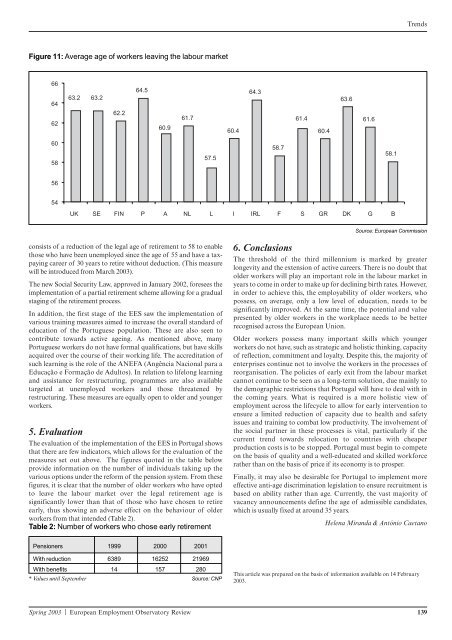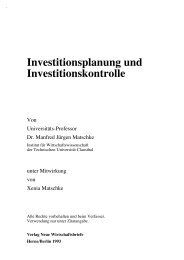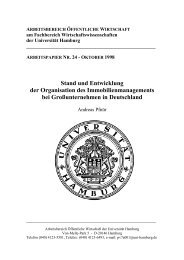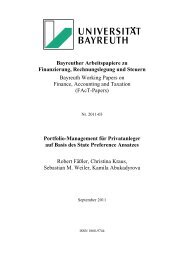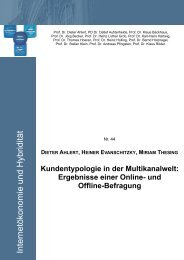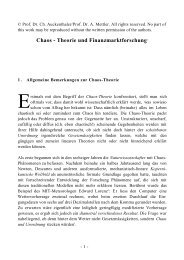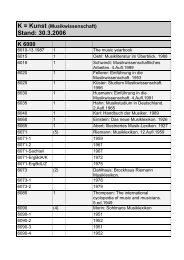FRANCE The
FRANCE The
FRANCE The
Create successful ePaper yourself
Turn your PDF publications into a flip-book with our unique Google optimized e-Paper software.
Figure 11: Average age of workers leaving the labour market<br />
66<br />
64<br />
62<br />
60<br />
58<br />
56<br />
54<br />
63.2 63.2<br />
62.2<br />
64.5<br />
60.9<br />
61.7<br />
UK SE FIN P A NL L I IRL F S GR DK G B<br />
consists of a reduction of the legal age of retirement to 58 to enable<br />
those who have been unemployed since the age of 55 and have a taxpaying<br />
career of 30 years to retire without deduction. (This measure<br />
will be introduced from March 2003).<br />
<strong>The</strong> new Social Security Law, approved in January 2002, foresees the<br />
implementation of a partial retirement scheme allowing for a gradual<br />
staging of the retirement process.<br />
In addition, the first stage of the EES saw the implementation of<br />
various training measures aimed to increase the overall standard of<br />
education of the Portuguese population. <strong>The</strong>se are also seen to<br />
contribute towards active ageing. As mentioned above, many<br />
Portuguese workers do not have formal qualifications, but have skills<br />
acquired over the course of their working life. <strong>The</strong> accreditation of<br />
such learning is the role of the ANEFA (Angência Nacional para a<br />
Educação e Formação de Adultos). In relation to lifelong learning<br />
and assistance for restructuring, programmes are also available<br />
targeted at unemployed workers and those threatened by<br />
restructuring. <strong>The</strong>se measures are equally open to older and younger<br />
workers.<br />
5. Evaluation<br />
<strong>The</strong> evaluation of the implementation of the EES in Portugal shows<br />
that there are few indicators, which allows for the evaluation of the<br />
measures set out above. <strong>The</strong> figures quoted in the table below<br />
provide information on the number of individuals taking up the<br />
various options under the reform of the pension system. From these<br />
figures, it is clear that the number of older workers who have opted<br />
to leave the labour market over the legal retirement age is<br />
significantly lower than that of those who have chosen to retire<br />
early, thus showing an adverse effect on the behaviour of older<br />
workers from that intended (Table 2).<br />
Table 2: Number of workers who chose early retirement<br />
Pensioners 1999 2000 2001<br />
57.5<br />
With reduction 6389 16252 21969<br />
With benefits 14 157 280<br />
* Values until September Source: CNP<br />
60.4<br />
Spring 2003 | European Employment Observatory Review 139<br />
64.3<br />
58.7<br />
61.4<br />
60.4<br />
63.6<br />
61.6<br />
58.1<br />
Trends<br />
Source: European Commission<br />
6. Conclusions<br />
<strong>The</strong> threshold of the third millennium is marked by greater<br />
longevity and the extension of active careers. <strong>The</strong>re is no doubt that<br />
older workers will play an important role in the labour market in<br />
years to come in order to make up for declining birth rates. However,<br />
in order to achieve this, the employability of older workers, who<br />
possess, on average, only a low level of education, needs to be<br />
significantly improved. At the same time, the potential and value<br />
presented by older workers in the workplace needs to be better<br />
recognised across the European Union.<br />
Older workers possess many important skills which younger<br />
workers do not have, such as strategic and holistic thinking, capacity<br />
of reflection, commitment and loyalty. Despite this, the majority of<br />
enterprises continue not to involve the workers in the processes of<br />
reorganisation. <strong>The</strong> policies of early exit from the labour market<br />
cannot continue to be seen as a long-term solution, due mainly to<br />
the demographic restrictions that Portugal will have to deal with in<br />
the coming years. What is required is a more holistic view of<br />
employment across the lifecycle to allow for early intervention to<br />
ensure a limited reduction of capacity due to health and safety<br />
issues and training to combat low productivity. <strong>The</strong> involvement of<br />
the social partner in these processes is vital, particularly if the<br />
current trend towards relocation to countries with cheaper<br />
production costs is to be stopped. Portugal must begin to compete<br />
on the basis of quality and a well-educated and skilled workforce<br />
rather than on the basis of price if its economy is to prosper.<br />
Finally, it may also be desirable for Portugal to implement more<br />
effective anti-age discrimination legislation to ensure recruitment is<br />
based on ability rather than age. Currently, the vast majority of<br />
vacancy announcements define the age of admissible candidates,<br />
which is usually fixed at around 35 years.<br />
Helena Miranda & António Caetano<br />
This article was prepared on the basis of information available on 14 February<br />
2003.


